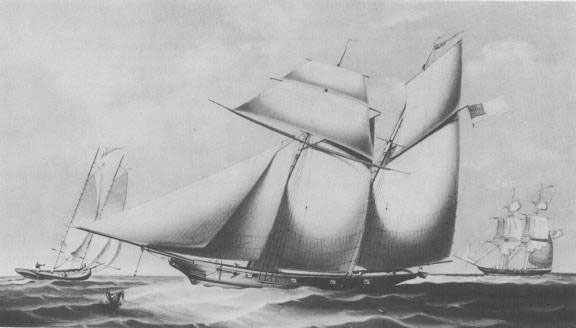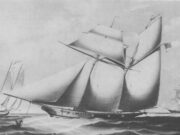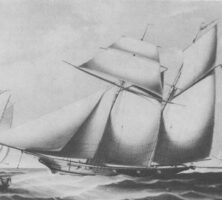The Wanderer was the last ship to bring enslaved people from Africa to Georgia and one of the last ships to smuggle bondsmen to American soil. On November 28, 1858, the Wanderer arrived at Jekyll Island, where its crew smuggled ashore 409 West African captives.

The incident is especially noteworthy because the federal Slave Importation Act, passed in 1807, had officially banned the foreign importation of enslaved people into the United States. News of the Wanderer and its cargo quickly spread across the country and contributed to the sectional tensions between the North and the South that would soon lead to secession and the Civil War (1861-65).
Beginnings
Late in 1857 Colonel John D. Johnson, a New Orleans, Louisiana, sugar baron who was also a member of the prestigious New York [City] Yacht Club, commissioned a 238-ton luxury sailing vessel to be built on Long Island for his personal use. Upon its completion, the Wanderer was considered to be one of the world’s most impressive privately owned pleasure crafts. Of particular note was the ship’s ability to achieve high speeds; its streamlined design allowed it to sail at a maximum of twenty knots per hour.
Despite the ship’s attributes, Johnson, for whatever reason, did not keep the Wanderer for long. In 1858, while on a voyage back to New Orleans, Johnson sold the vessel for $25,000 to William C. Corrie in Charleston, South Carolina. Corrie, a prominent South Carolinian with strong ties to political circles in Washington, D.C., and to the elite business community of New York City, hoped that the purchase of the Wanderer would afford him admittance into the New York Yacht Club and catapult him into some of the city’s most exclusive social groups.
The Wanderer as Slave Ship
Shortly after his purchase, Corrie was approached by business associate Charles A. L. Lamar of Savannah, who proposed that together they retrofit the Wanderer and convert it into a slave ship. Lamar, a descendent of a prominent Savannah family that included the second president of the Republic of Texas, a U.S. Supreme Court justice, and U.S. treasury secretary Howell Cobb, was a “fire-eating” radical who had long opposed the U.S. government’s restriction on the importation of enslaved people. Corrie agreed to his associate’s proposition.
Corrie returned the Wanderer to New York and oversaw its transformation from luxury yacht to rudimentary slave transport. One of the last alterations he requested was storage, with the capacity to hold 15,000 gallons of drinking water. Some observers were suspicious that this and other modifications indicated that the vessel would be used to smuggle enslaved people. Despite the rumors and red flags, however, the Wanderer managed to pass all inspections and was subsequently cleared for its voyage.
On June 18, 1858, the Wanderer departed from the New York harbor, arriving in Charleston seven days later. There it was further transformed; foodstuffs, pans, and tins were put aboard, along with sufficient Georgia pine to construct a second deck beneath the existing 114-foot main deck once the ship reached Africa. Its conversion complete, the Wanderer set sail for Africa. Still flying the triangular pennant of the New York Yacht Club, the former luxury ship arrived at the mouth of the Congo River, in present-day Angola, on September 16, 1858. Although portions of the West African coastline were patrolled by the British navy, specifically the British African Squadron, which sought to prevent the penetration of illegal slave traders, the Wanderer and its crew easily sailed up the Congo to areas where captives were readily available. It was on that river that Corrie and Lamar made contact with one Captain Snelgrave, a representative for an illegal New York slave-trading firm.
After a period of negotiation, Corrie and Lamar placed an order with Snelgrave for 500 Africans, who were to be delivered to the Atlantic beaches from the barracoons, or slave warehouses, higher up on the Congo. The Americans paid for the African captives, at a rate of $50 per head, with rum, gunpowder, cutlasses, and muskets rather than with paper or gold. The entire transaction was completed in less than a month, and by mid-October the Wanderer had begun its return voyage to the United States.
The ship arrived at Jekyll Island (a considerably more clandestine point of entry than Savannah) on November 28, 1858. The entry point had been arranged by Henry DuBignon Jr., who owned Jekyll Island and had conspired with Corrie and Lamar from the beginning. Of the 487 Africans on board, 78 perished en route, and except for the mortality figures, little else is known about the middle passage experience. Within a matter of days Lamar and Corrie dispatched the survivors to slave markets in Savannah and Augusta, as well as to markets in South Carolina and Florida.
Aftermath of the Wanderer
Although Corrie, Lamar, and others associated with the Wanderer and its illegal activities arrogantly believed that their smuggling efforts had been successful, locals quickly spread the word that newly imported Africans had been spotted on native soil. Later evidence revealed that the crew of the Wanderer had presented counterfeit documentation to the authorities, a discovery that led to an investigation of the ship’s activities. As a result of the inquiry, Lamar, Corrie, and his conspirators were tried in federal court in Savannah on three separate counts of piracy in May 1860. Prosecutors were unsuccessful in proving their case, however, and the local jury returned a verdict of not guilty. No doubt Lamar’s status as one of Savannah’s leading citizens played a pivotal role in the acquittal.
The Wanderer incident incensed many northerners and contributed to the increasingly strained and deteriorating relationship between the North and the South. U.S. president James Buchanan responded to the Wanderer incident by proposing that the federal government adopt a more aggressive stance against the slave trade.
A little more than a year later, the Civil War began. In the spring of 1861 Union troops seized the Wanderer as an enemy vessel at Key West, Florida. The Union navy converted the ship and used it for various purposes, including gunboat, tender, and hospital ship. At some point after 1865 the Wanderer was purchased by a private citizen and sailed commercially until December 28, 1870, when it sank in the Caribbean, off the coast of Cuba.





